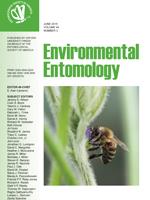The objective of this study was to document current areas of subterranean termite activity in Wisconsin and to evaluate genetic characteristics of these northern, peripheral colonies. Here, amplified fragment-length polymorphism was used to characterize levels of inbreeding, expected heterozygosity, and percent polymorphism within colonies as well as genetic structure among populations sampled. Genetic analysis revealed two species of termites occur in Wisconsin, Reticulitermes flavipes (Kollar) and Reticulitermes tibialis Banks, both found in the southern half of the state. Colonies of both species in Wisconsin are thought to represent the northern boundary of their current distributions. Measurements of within colony genetic variation showed the proportion of polymorphic loci to be between 52.9–63.9% and expected heterozygosity to range from 0.122–0.189. Consistent with geographical isolation, strong intercolony genetic differences were observed, with over 50% of FST values above 0.25 and the remaining showing moderate levels of genetic differentiation. Combined with low levels of inbreeding in most collection locations (FIS 0.042–0.123), we hypothesize termites were introduced numerous times in the state, likely by anthropogenic means. We discuss the potential effects of these genetic characteristics on successful colony establishment of termites along the northern boundary compared with termites in the core region of their distribution.
How to translate text using browser tools
1 June 2015
Genetic Analysis of Termite Colonies in Wisconsin
R. A. Arango,
D. A. Marschalek,
F. Green,
K. F. Raffa,
M. E. Berres
ACCESS THE FULL ARTICLE
It is not available for individual sale.
This article is only available to subscribers.
It is not available for individual sale.
It is not available for individual sale.

Environmental Entomology
Vol. 44 • No. 3
June 2015
Vol. 44 • No. 3
June 2015
amplified fragment-length polymorphism
GENELAND
genetic population structure
Reticulitermes flavipes (Kollar)
Reticulitermes tibialis Banks




